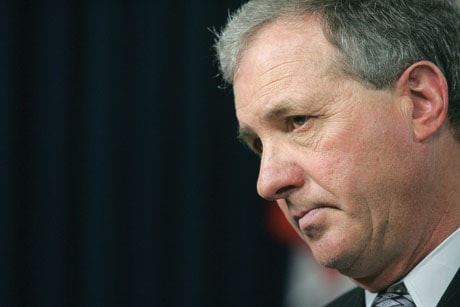EDMONTON — Recession-shocked Alberta appears ready to put its credit card on the table rather than take out a scalpel to make deep cuts to health care.
Health Minister Ron Liepert has told The Canadian Press that some changes are coming, but the province won’t see a repeat of the budget slashing that occurred in the 1990s when thousands of Alberta doctors and nurses lost their jobs.
The minister says his department, already faced with long waiting lists for some services, is sorting out “the nice-to-haves versus the absolutely-need-to-haves.”
“If you take a look at what it is that we actually cover in Alberta versus what the Canada Health Act requires that we cover, there are probably (up to 35) areas that by law we do not have to fund,” said Liepert. “We have to take a look across the board and then on a case-by-case basis say, ‘Is this still the right thing for us to be funding?”’
To avoid deeper cuts, Liepert wants the province to absorb a $350-million debt being carried by the superboard which oversees health-care delivery in the province. He’s also talking about some form of relief to help the board deal with a projected $1-billion deficit this year.
“It’s going to show up one way or another on the provincial debt meter, so we’ll have to deal with it.”
Red ink is becoming a big issue in Alberta. The province recently recorded its first deficit budget in 15 years and a $7-billion shortfall looms this year.
Liepert may be facing a tough sell in the cabinet room over helping the health board with its money woes.
But the president of the Canadian Medical Association, who just completed a three-week European tour to examine ways to control health costs, likes Liepert’s approach.
“I think it’s probably the way to go right now because we don’t want to go back to the cuts that were made, not only in Alberta, but in all the provinces and at the federal level in the 1990s,” Dr. Robert Ouellet said in an interview from Montreal.
“We’re still suffering from that.”
Other provinces are also scrambling to deal with health-care operating deficits. In British Columbia this week, the health minister told regional health authorities to cut costs to avoid a $360-million deficit and warned them the province won’t be providing any bailouts. That is likely to mean longer waits for MRIs and elective surgeries.
Every province and territory plans to spend more money on health care this year, but whether the extra dollars will help remains to be seen on hospital floors. In Ontario, the $42-billion health budget is up $2 billion from 2008-09. But the Ontario Health Coalition is still warning of hospitals with mounting debts and plans to close emergency rooms.
“At least 70 per cent of Ontario’s hospitals have been pushed into deficit as a result of provincial government funding levels that are less than the rate of inflation,” the coalition said last month.
The booming economy in Newfoundland and Labrador has allowed its government to push this year’s health budget 10 per cent higher. Saskatchewan is spending nine per cent more and is still having trouble filling 600 vacant nursing jobs.
Alberta’s health board is penny-pinching. Hospital budgets are being held at last year’s levels, which has resulted in surgeries and MRIs being delayed for months in some cases. But the overall health budget is still increasing by nearly five per cent to almost $13 billion.
That doesn’t mean there haven’t been several contentious changes.
Medicare coverage for chiropractic treatments has been phased out, sex-change operations have been delisted and a subsidy program has shifted drug costs onto middle- and high-income seniors.
The province’s nurses union has calculated that Alberta is short 1,500 RNs, but job postings have become rare. Nurses say they are feeling the pressure with shifts of up to 16 hours, denied vacation requests and an order not to complain to the news media.
Heather Smith, president of the United Nurses of Alberta, says she’s concerned about the impact of cost controls already in place and the effect of what’s to come — in whatever form that may be.
“Death by a thousands cuts is still death, so whether it’s a few big, brutal cuts or multiple little cuts, you still end up with the same result,” she said. “Changes already made have affected thousands upon thousands of citizens, although not to the same degree as closing a 600-bed hospital.”
The Canadian Medical Association will be presenting some new ideas on cost-effective health care operations at its annual meeting this fall.
Canada ranked 23rd in a study that compared it with 29 European countries in terms of health-care value for money spent.
Ouellet said what’s needed in the long term is to make the kind of changes that have worked in Europe and elsewhere.
Six years ago, England had the same lengthy wait times that many provinces are currently dealing with, but found a solution with a new financing model and incentives for hospitals to treat patients faster, he said.
“For emergency rooms, there’s a target of four hours of wait time, which is not unreasonable here in Quebec,” he said. “And their system doesn’t cost more than what we’re paying for our system.”
“So anything is possible.”
